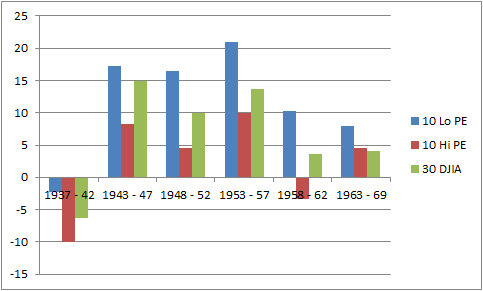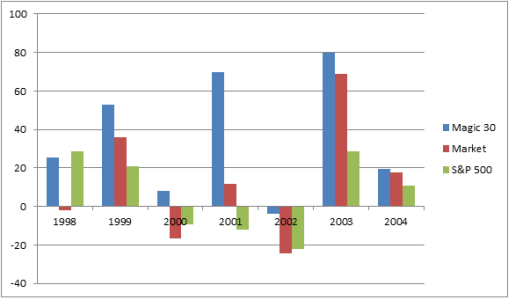Stock Ranking Systems
Stock ranking systems are used to order a universe of stocks with the expectation that higher ranked stocks will outperform lower ranked stocks. We all want to pick investments from the pool of companies most likely to succeed - just like we want to fish in the spot where the fish are worth catching. Ranking stocks should improve the performance of both qualitative and quantitative styles of investing.
Single Variable Ranking
Benjamin Graham in the 4th edition of his book, The Intelligent Investor, suggested ranking the 30 stocks of the Dow Jones Industrial Average according to their Price to Earnings (PE) ratio and buying those with the lowest PE ratio. NOTE: The Dogs of the Dow strategy described elsewhere on this site is a modern version of this idea.
The study examined the results of holding the 10 low-multiple PE stocks or the 10 high-multiple PE stocks of the Dow Jones Industrial Average for 5 years. From the chart, it is clear that the low PE stocks outperformed both the high PE stocks and the 30 stocks of the DJIA in this study.

One of the first published studies on ranking was by Francis Nicholson in 1968. He used a universe of trust company grade stocks (blue chips) and divided the stocks into 5 groups (quintiles) according to their PE ratios. The 20% with the lowest PE ratio were put in a group and so on to the 20% with the highest PE ratio. Over the period from 1937 - 1962, portfolios were created for each quintile with holding periods of 1 to 7 years. At the end of 35 years, the portfolios created from low PE stocks outperformed regardless of the holding period.
Many of the early studies were handicapped by a lack of data and were often restricted to annual holding periods beginning on January 1. Annual holding periods that were begun on the 1st of every month were included in the later studies.
The conflict with proponents of the Efficient Market Hypothesis (EMH) was also a drawback to acceptance of studies which recommended buying "losers". If the markets are efficient, buying losers meant taking additional risk. Later work by EMH theorists (e.g. Fama and French) overcame this.
Multiple Variable Stock Ranking Systems
In 2004, Joel Greenblatt introduced the "Magic Formula", a 2 variable stock ranking system, in his book The Little Book that Beats the Market. Rather than rank stocks by a single variable, Greenblatt uses 2 variables; Earnings Yield and Return on Capital. Each stock is rated by Earnings Yield and given a score. Then each stock is ranked by Return on Capital and given a score. The final ranking for each stock is the sum of the 2 scores.
The published results cover 17 years (1987 - 2004) but instead of 17 1-year holding periods, there are 173 since a new holding period is started every month and included in the results. The number of stocks held was 30. Although the study was further broken out by market cap, the performance listed in the following chart is for large cap stocks (only the last 7 years of the study are shown).

Note that the market represents buying the stocks of the 3500 stock universe in equal weights while the S&P 5oo index stats are cap-weighted. In ranking systems, the performance should be compared to an equal-weighted version of the stock universe involved.
Greenblatt recommends sticking with the Magic Formula for at least 3 years since in back-testing it outperformed the market at least 95% of the time.
NOTE: He also recommends NEVER investing in individual stocks unless you have Market Analyst type expertise.
How many variables can be included in a stock ranking system? Robert Haugen includes over 60. A bit much for most of us, but you can check his system out if you like complexity.
Over 30 multi-variable ranking systems are available within the stock screeners on Portfolio123. Portfolio123 allows you access to the internals of their ranking systems as well as back-test system performance. You can also create and back-test your own system. Check out the Portfolio123 review for more details.
Types of Systems
There are 2 general categories of stock ranking systems - qualitative and quantitative. Part 2 describes these in more detail.
Part 2: Qualitative and Quantitative Stock Ranking Systems
HOME | Site Policies | Contact Us | About Me | About Site | Site Map
Popular Pages
CANSLIM Strategy
Folio Investing
Economic Indicators
Portfolio123
Ranking Systems
New
We value your suggestions, comments, and questions.
Our goal is to make this site as useful as possible.
Contact Us
Thanks!
Stock screening tools and consistent, sustainable investing processes.
About Me
Why build a website instead of a blog?
About this site
Jan 2017